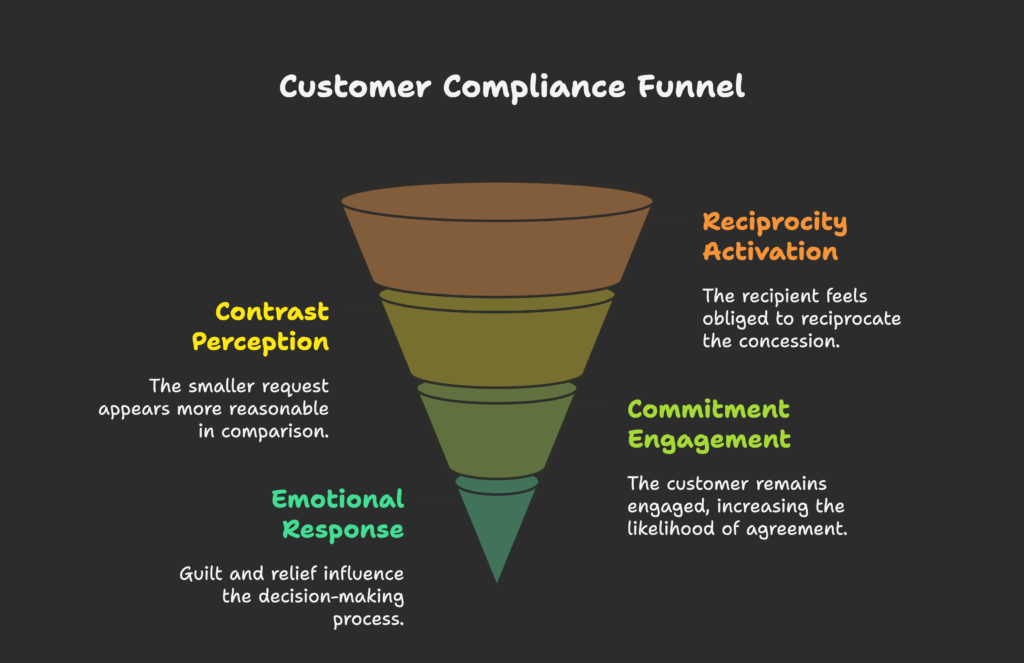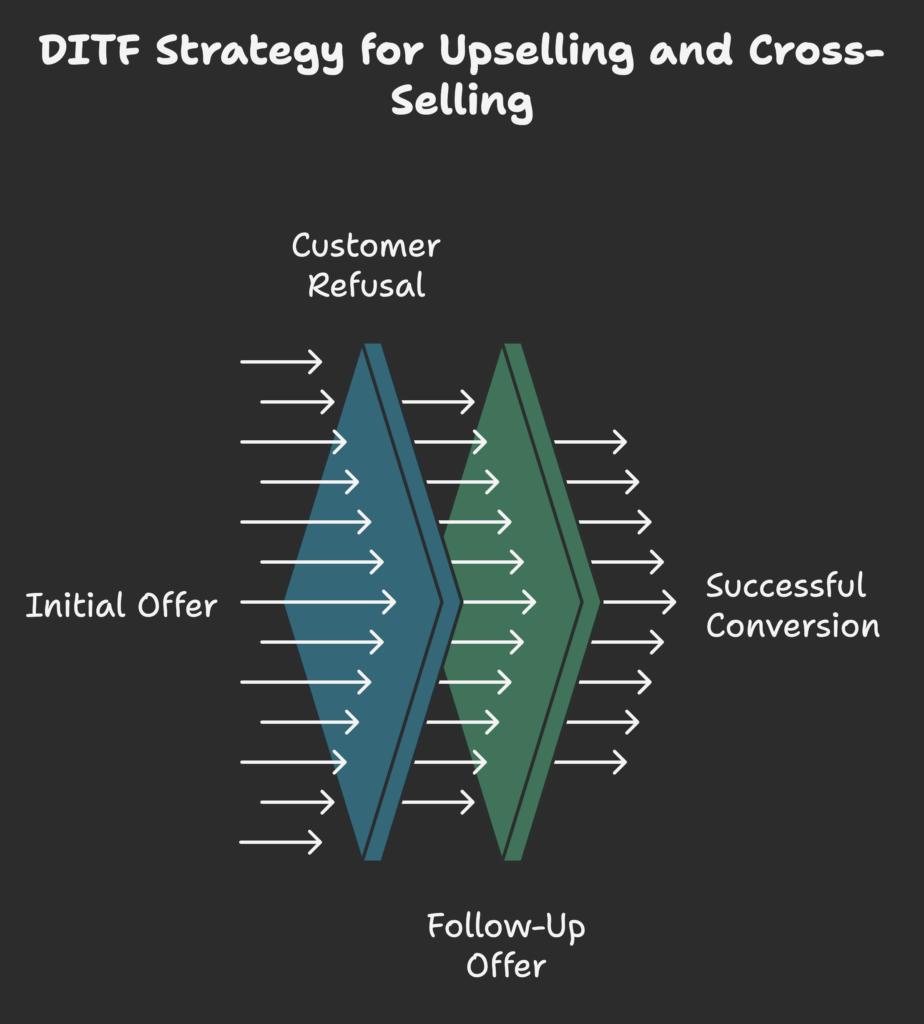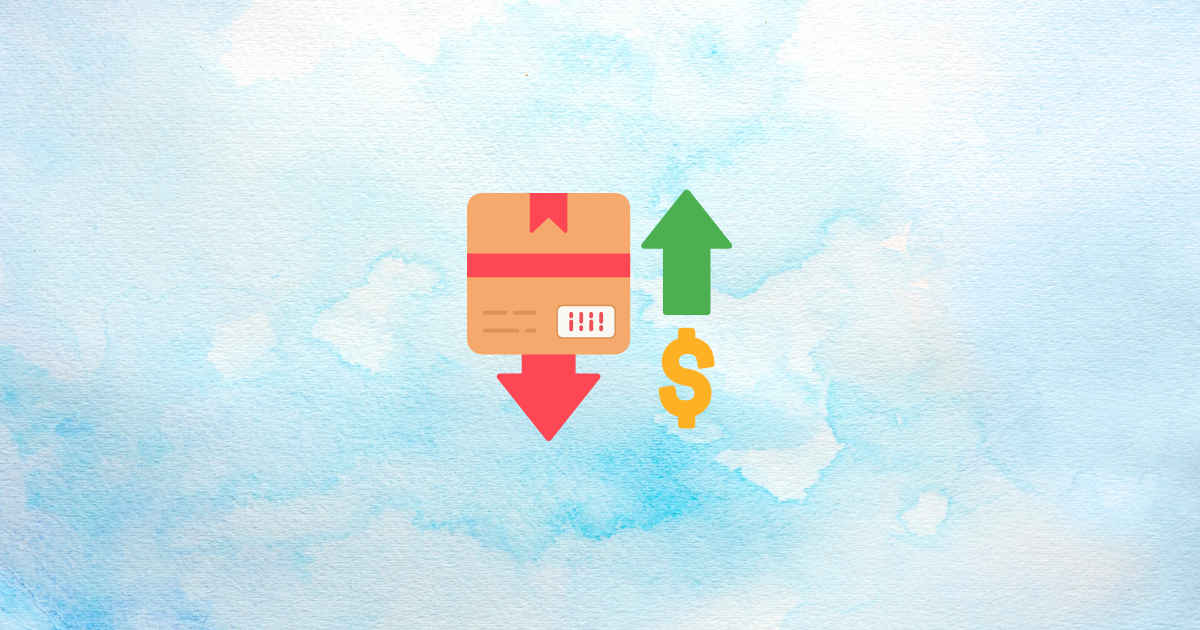Have you ever had someone ask for a big favor, you said “no,” and then they followed up with a smaller request that you suddenly felt compelled to accept? That’s the magic of the Door-in-the-Face technique! By reading this article, you’ll discover how this fascinating psychology principle can help you upsell or cross-sell products more effectively—without annoying your customers. Ready to master this clever approach to boosting sales? Let’s go!
In this section: We’ll define what the Door-in-the-Face (DITF) method is, explore where it came from, and see why it’s a powerful tool for modern marketers. You’ll learn how an initial large request (likely to be refused) can warm people up to saying “yes” to a smaller ask, enhancing your revenue opportunities.
Definition and Conceptual Framework
The Door-in-the-Face technique is a persuasion strategy where you start with a big request that consumers will probably refuse. Immediately after they say “no,” you make a second, smaller request—which, compared to the initial one, seems much more manageable. The concept was introduced by Robert Cialdini in his 1975 research, illustrating how *reciprocity* and *contrast effect* can dramatically increase compliance. Essentially, customers feel that by refusing your first ask, they “owe” you some sort of concession, making them more likely to accept the second, more modest proposal.
Applications in Sales and Marketing
Historically, DITF appeared in door-to-door fundraising and negotiation. Today, digital marketers deploy it for upsells (offering a premium package first, then a standard or reduced package if refused) and cross-sells (proposing a big bundle, then falling back to one or two complementary items when the bundle is rejected). This tactic can be extremely effective in e-commerce, email campaigns, or face-to-face retail scenarios. Its economic significance lies in increasing conversion rates and average order value by reframing an offer as more “reasonable” through comparison with a larger, rejected request.
The Business Case for DITF in Upselling and Cross-Selling
Research shows that DITF can boost compliance rates by up to 37% compared to standalone smaller requests. Over time, effectively managed DITF strategies can raise your average order size, strengthen customer relationships, and differentiate your brand. It’s not just about making quick extra sales; it’s about smart persuasion that feels less pushy because it gives customers a chance to reject the big ask and then “help you out” with the next offer.
We’ve introduced the technique. Now, let’s dig into the psychology behind why it works so well, from the reciprocity principle to emotional triggers like guilt and relief.
Psychological Foundations of the Door-in-the-Face Technique
In this section: We’ll see how reciprocity, contrast, and commitment fuel DITF, and how customers’ emotional reactions lead them to say “yes” to that second request.

Reciprocity Principle
When someone “concedes” by lowering their request from big to small, the recipient feels a subtle obligation to reciprocate that kindness. They perceive the second offer as a compromise, which activates guilt if they refuse again. Consequently, they’re more inclined to cooperate—this sense of give-and-take fosters compliance. The bigger the initial request, the more pronounced the concession seems, so be sure it’s large enough to be declined but not so large as to be absurd.
Contrast Effect
The first large ask acts as an anchor. When customers see a subsequent, smaller request, it feels comparatively less daunting—even if that smaller request is actually substantial. This *contrast effect* makes your second pitch look more appealing. For instance, if you propose a $200 subscription at first and quickly follow up with a $50 plan, that $50 can seem like a real bargain, increasing acceptance.
Commitment and Consistency
Though the user initially says “no,” they’re still engaged in a conversation or browsing session. By continuing the negotiation, they remain in a psychologically active state of readiness. Their innate desire to appear consistent (not completely unwilling) can nudge them to say “yes” the second time around, to show they aren’t uncooperative.
Emotional Responses in Decision-Making
Saying “no” can spark *guilt* or a sense of relief at having avoided a big expense. Then, the shopper sees a more reasonable second offer, which might register as “I can do that.” Emotional factors—like wanting to maintain a positive self-image or not wishing to disappoint—play a big role. This synergy of guilt and relief helps convert a potential “no” into “sure, why not?” on the second attempt.
We now know the science behind it. Next, we’ll explore how the DITF approach translates to upselling and cross-selling in real e-commerce scenarios, from fancy upgrades to complementary products.
Mechanisms of DITF in Upselling and Cross-Selling
In this section: We’ll specify how DITF looks in practice, whether you’re nudging customers toward a higher-level plan (upsell) or additional products (cross-sell). You’ll learn how to structure your offers and time them correctly.

Upselling Applications
Picture an online electronics store. You initially pitch a premium laptop with advanced features at a higher price. If the customer balks, you pivot to a slightly less expensive model with fewer bells and whistles. The difference in cost and features stands out, making the second laptop feel more “affordable” and a good compromise. This same logic applies to hotel room categories, service tiers, or subscription levels (e.g., “Ultimate Plan” then “Pro Plan”).
Cross-Selling Applications
Instead of a big upgrade, the first request might be a large, multi-item bundle or kit. If refused, you scale down to a single accessory or add-on that seems modest in comparison. For instance, imagine a kitchen gadget site offering a six-piece knife set first, then falling back to just the chef’s knife if the user declines. This approach can effectively bump average order value while still feeling fair to the customer.
Sequential Request Strategy Design
- Offer Setup: The first request must be significant but still relevant—no point in proposing a $10k service to a casual buyer if they only want a $20 item.
- Immediate Follow-Up: Don’t wait too long. The second request should appear soon after the first refusal, while the user’s sense of the “big ask” is fresh.
- Contrast Strength: Ensure the second offer is clearly smaller and simpler to accept. This stark contrast is the technique’s backbone.
If done right, DITF can feel like a genuine concession from your side, fostering positivity rather than resentment.
Now let’s shift from theory to digital tactics, covering email marketing, websites, and social media so you can deploy DITF with style.
Implementation Strategies for DITF in Digital Marketing
In this section: We’ll apply the DITF technique across multiple digital channels, from carefully orchestrated email campaigns to embedded website modules and social media retargeting ads.
Email Marketing Campaigns
- Initial Email: Introduce a high-value bundle or premium subscription with a strong pitch. Expect some unsubscribes or rejections, but that’s part of the plan.
- Follow-Up Email: Soon after, offer a discounted or scaled-down alternative. Use language like “We heard you. Here’s a more affordable, still-awesome option.”
- Personalization: Segment your list so the big request matches what’s relevant. For example, heavy users might get bigger offers, while new subscribers get smaller ones initially.
Timing matters: typically sending the second email a few days after the first helps keep the initial refusal top-of-mind.
Website Design Integration
- Pop-ups: If visitors reject an expensive bundle by closing a pop-up, show a second pop-up with a simpler, cheaper offer.
- Checkout Page: Attempt an upsell for a deluxe version first. If the user clicks “no, thanks,” a cross-sell at a smaller add-on price might follow.
- Exit-Intent Overlays: Detect if they’re about to leave, offering a big product or plan, then pivot to a smaller offer if refused.
This digital approach is like a conversation: the user signals “no,” and your site politely proposes a more modest request instead.
Social Media Advertising Campaigns
One way is to show a big promotional ad for an expensive product or service. Users who interact but don’t convert can be retargeted with a second ad for a lower-priced alternative. This retargeting structure fits the DITF logic perfectly, letting you visually contrast the big offering with the smaller follow-up. Over time, you can measure which approach yields the best ROI and refine your ad creative accordingly.
So you’ve deployed DITF across your channels—but how do you know if it’s working? Let’s explore the metrics and testing methods next.
Measuring the Effectiveness of DITF Strategies
In this section: We’ll talk about quantifying success, designing meaningful tests, and using analytics to uncover user responses to your DITF-based offers.
Key Performance Indicators (KPIs) for DITF Success
- Compliance Rate: The percentage of users who accept the second, smaller offer after refusing the first.
- Conversion Rate Changes: Compare typical conversion stats to those achieved under a DITF approach.
- Customer Retention: Are these upsold or cross-sold customers staying loyal, or do they feel pressured and churn quickly?
Testing Methodologies for Optimization
- A/B Testing: Show half your audience the DITF sequence and the other half a single-offer approach. Measure compliance differences.
- Multi-Variate Testing: Tweak the size or timing of the first request to find the sweet spot for refusal but not hostility.
Data might show that making the big ask “too big” can cause an immediate negative reaction, whereas a moderately big ask might yield better second-offer compliance.
Behavioral Analytics Integration
Use heatmaps or session replays on your site to see if users are engaging with or ignoring the large request. Track how many clicks or dwell times occur around the second offer. Combined with standard metrics, these behavioral insights help refine your approach so you’re not just guessing at user responses.
But watch out: As with any persuasive tactic, there’s a fine line between effective marketing and manipulation. Let’s explore ethical boundaries now.
Ethical Considerations in DITF Usage
In this section: We’ll review how to stay transparent, keep user trust intact, and avoid crossing into manipulative territory while employing DITF in your upselling and cross-selling strategies.
Transparency in Offer Framing
Ensure your customers realize both the first (big) and second (smaller) offers are legitimate and beneficial. Don’t artificially inflate the initial ask just to appear you’re giving a “massive discount” on the second. If shoppers sense trickery or inflated pricing, your credibility takes a hit. Maintain genuine integrity in each request’s pricing and value propositions.
Balancing Persuasion with User Autonomy
While DITF leverages social and psychological factors, always respect a user’s right to say “no” at any point. Overdoing it—like bombarding them with repeated “What about this smaller option?” pop-ups—could annoy them into leaving your site for good. Keep a healthy user experience in mind and treat the DITF method as a polite suggestion, not an unrelenting push.
Now that we understand the do’s and don’ts, let’s see real success stories across different sectors—hotels, online stores, SaaS—and how they gracefully apply DITF for better revenue.
Case Studies of Successful DITF Implementation
In this section: We’ll highlight how different industries, from hotels to online fashion, have used DITF strategies to grow sales, concluding with key lessons from their experiences.
Hospitality Industry Success Stories
- Hotel Upgrades: They might first propose a suite with VIP amenities. If you decline, they pivot to a smaller but still nicer room upgrade. This can significantly lift the average booking value.
- Restaurant Menu Cross-Sell: Offer a deluxe multi-course meal first, then retreat to a single recommended dish or a dessert pairing if diners resist the bigger splurge.
In each case, the difference between the “door in the face” request and the “smaller” acceptance can be big enough to add real revenue, yet small enough to feel acceptable.
E-commerce Applications
- Fashion Retailers: Some try to get you to buy a high-end outfit set, then fallback to selling you just a matching jacket or shoes if you refuse the entire set.
- Electronics Warranties: The store might initially present an extensive 3-year premium warranty. If turned down, a cheaper 1-year plan or a single “accident coverage” add-on is offered, boosting upsell acceptance.
SaaS Platforms Using DITF Techniques
Many software services pitch the top-tier enterprise plan with advanced features. If that’s too big a leap, they propose a “Pro” or “Basic” plan at a lower monthly cost. Meanwhile, freemium-based SaaS might present you a robust paid upgrade after your trial ends, then “settle” for a partial paid tier if you’re reluctant. This logic helps maintain user engagement even if they’re not ready for the top rung.
Finally, we’ll see what the future holds for DITF, with AI-based personalization and cutting-edge technologies that might streamline or transform how big and small offers are delivered.
Future Trends in DITF-Based Sales Strategies
In this section: We’ll peek at how artificial intelligence, augmented reality, and other breakthroughs could refine the DITF approach, making it more personalized, data-driven, and interactive.
AI-Driven Personalization of Requests
AI can dynamically determine the ideal “big request” by analyzing user profiles, browsing history, or previous purchases. Instead of a static offer, machine learning might propose a specifically chosen large item or bundle likely to be just beyond the user’s comfort range, ensuring a refusal. Then it quickly pivots to an alternative that’s more appealing or aligned with user data, maximizing acceptance rates in real time.
Integration with Emerging Technologies
- Augmented Reality: Perhaps you invite users to a VR store with high-end product lines first. If they say “no thanks,” the system transitions them to mid-range or complementary items.
- Voice Commerce: Smart assistants could verbally present the bigger, more expensive plan, then verbally pivot to a lighter alternative if the user hesitates.
As technology merges with user interactions, the DITF principle can adapt seamlessly, still retaining that essential psychological dynamic.
We’ve covered the entire journey of the Door-in-the-Face technique. Let’s conclude with final recommendations and the bigger picture of how DITF can become a long-term advantage for your business.
Conclusion and Strategic Recommendations
In this section: We’ll summarize the main points on implementing DITF, emphasize how to remain ethical, and outline the lasting benefits—beyond quick revenue boosts—of effective DITF usage.
Core Principles for Effective DITF Implementation
- Contrast is Key: The larger ask must be substantial enough for the follow-up to look attractive, but not too outrageous to cause distrust.
- Maintain Genuine Value: Both the big request and the smaller offer should have real appeal—no trick pricing or worthless add-ons.
- Respect User Autonomy: Don’t barrage customers with repeated fallback offers if they remain uninterested.
- Refine with Data: Use analytics and testing to find the “sweet spot” for your initial requests and second offers.
Long-Term Benefits of DITF Strategies
Beyond immediate upsells, consistent use of DITF can train customers to see your brand as flexible and fair. They appreciate the chance to decline big requests and still feel good about the final purchase. Over time, such positive experiences can boost loyalty, referrals, and brand advocacy. A well-implemented DITF doesn’t just increase short-term sales; it also builds lasting relationships based on perceived respect for the shopper’s budget and preferences.
Quick Note: If you’re a Shopify store owner aiming to streamline your upselling and cross-selling tactics, consider the Growth Suite app. It helps automate your first big ask and second fallback offers, so you can harness the Door-in-the-Face method effectively—leading to higher average orders and happier, more engaged customers.
References
- Vimi.co (2022). B2B Marketing using Door-in-the-Face Technique. Link
- Catalys Blog (2023). Door In The Face Phenomenon. Link
- Simplicable Guide (2018). Examples of Door In The Face. Link
- Mentes Abiertas Psicología Blog (2023). Door-in-the-Face Technique Definition and Use. Link
- Psychologist World (2017). The Door-in-the-Face Technique as a Compliance Strategy. Link
- LinkedIn Insights (2023). How to Use the Door-in-the-Face Technique Effectively. Link
- Simplicable Business Blog (2013). Door in the Face Sales Strategy. Link
- MailBluster Blog (2024). The Door in the Face Technique Affecting Marketing. Link




